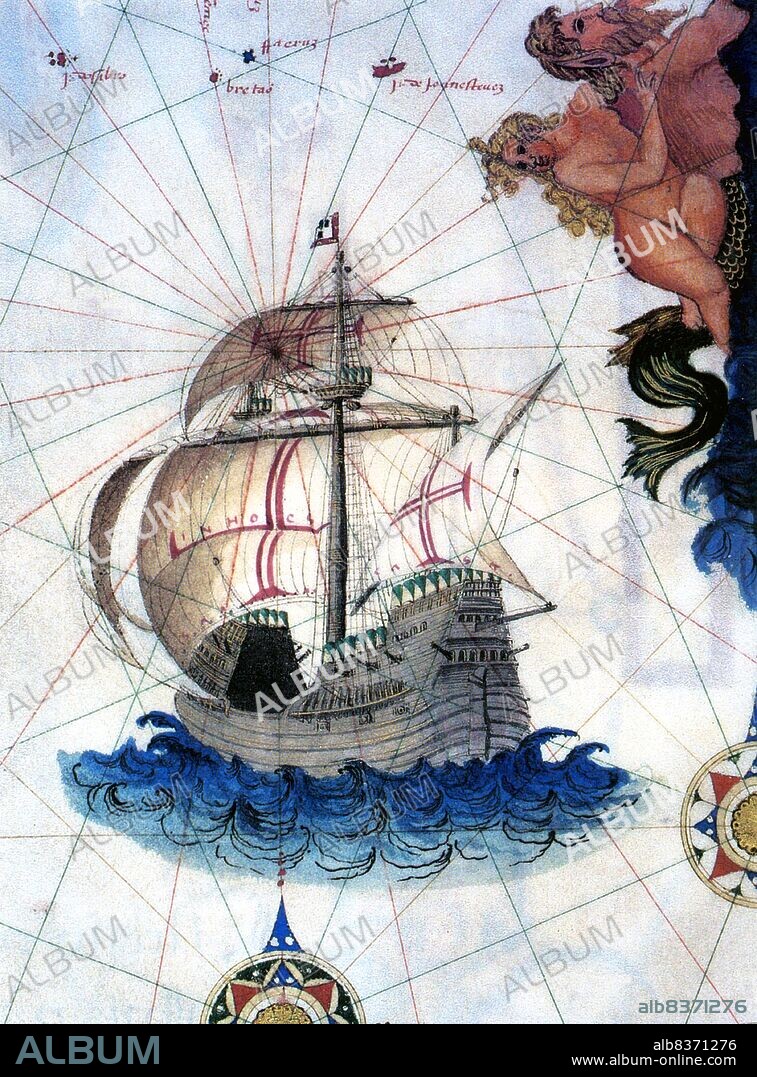alb8371276
Portugal: A Portuguese nau< / i> or carrack depicted in a Portuguese map dated 1565

|
Add to another lightbox |
|
Add to another lightbox |



Buy this image.
Select the use:

Title:
Portugal: A Portuguese nau< / i> or carrack depicted in a Portuguese map dated 1565
Caption:
A carrack was a three- or four-masted sailing ship developed in the 15th century by the Genoese for use in commerce. They were widely used by Europe's 15th-century maritime powers, from the Mediterranean to northwest Europe, although each region had models of slightly different design. The Portuguese and the Spanish used them for oceanic travel and to explore the world.
. With linguistic variation, these ships were called: caracca or nao in the Genoese dialect and in Castillian Spanish; nau in Portuguese; caraque or nef in French. The name carrack probably derives from the Arab Harraqa, a type of ship that first appeared along the shores of the Tigris and Euphrates rivers roughly during the 9th century.
. Carracks were ocean-going ships: large enough to be stable in heavy seas, and roomy enough to carry provisions for long voyages. They were usually square-rigged on the foremast and mainmast and lateen-rigged on the mizzenmast. They had a high rounded stern with large aftcastle, forecastle and bowsprit at the stem. As the forerunner of the great ships of the age of sail, the carrack was one of the most influential ship designs in history; while ships became more specialized, the basic design remained unchanged throughout this time period.
. With linguistic variation, these ships were called: caracca or nao in the Genoese dialect and in Castillian Spanish; nau in Portuguese; caraque or nef in French. The name carrack probably derives from the Arab Harraqa, a type of ship that first appeared along the shores of the Tigris and Euphrates rivers roughly during the 9th century.
. Carracks were ocean-going ships: large enough to be stable in heavy seas, and roomy enough to carry provisions for long voyages. They were usually square-rigged on the foremast and mainmast and lateen-rigged on the mizzenmast. They had a high rounded stern with large aftcastle, forecastle and bowsprit at the stem. As the forerunner of the great ships of the age of sail, the carrack was one of the most influential ship designs in history; while ships became more specialized, the basic design remained unchanged throughout this time period.
Credit:
Album / Universal Images Group / Pictures From History
Releases:
Image size:
3600 x 4871 px | 50.2 MB
Print size:
30.5 x 41.2 cm | 12.0 x 16.2 in (300 dpi)
Keywords:
1565 • ASIA • ASIAN • BOAT • BOATS • BOUTIQUE • CARGO • CARRACK • CARTOGRAPHY • CHART • COMMERCE • ECONOMY • MAP MAKING • MAP • MAPS • NAMBAN TRADE • NAMBAN • NAU • PLAN (CARTOGRAPHY) • PORTUGAL • PORTUGESE • PORTUGUESE • SAIL (REEFED) • SAIL • SAILING SHIP • SAILING VESSEL • SAILING • SAILOR • SEAMAN • SHIP • SHIPS BOW • SHIPS • TRADE • TRADING • TRANSPORT • TRANSPORT. • TRANSPORTATION • TRANSPORTS • VESSEL
 Pinterest
Pinterest Twitter
Twitter Facebook
Facebook Copy link
Copy link Email
Email
